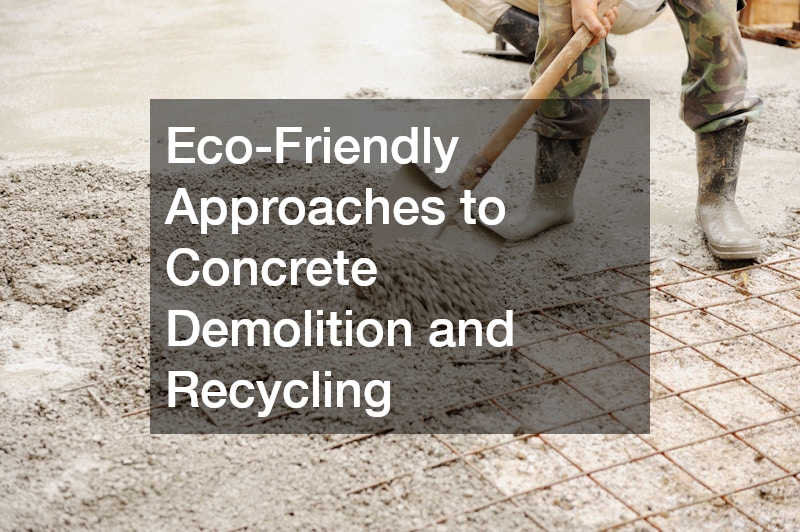The construction industry has been increasingly focusing on sustainable practices. This article explores eco-friendly approaches to concrete demolition and recycling, providing insights into innovative techniques, environmental benefits, and potential challenges.
The Most Sustainable Methods of Concrete Demolition
Mechanical Demolition Techniques
Mechanical demolition techniques are evolving to address the growing need for sustainability in construction. One of the most significant changes is the shift towards using electric-powered machinery for demolition tasks, which significantly reduces greenhouse gas emissions compared to traditional fossil-fuel-powered equipment.
This approach not only helps in minimizing emissions but also reduces noise pollution, which is beneficial for urban areas. Furthermore, these machines are often equipped with better technology for precision demolition, which aids in preserving materials for recycling.
The efficiency of mechanical demolition is further enhanced by the use of innovative methods like robotic demolition, designed to work in confined spaces. Robotic systems can dismantle structures piece by piece, allowing for better control and minimizing material wastage.
Advanced Cutting Technologies
Advanced cutting technologies such as diamond wire cutting are being adopted for their precision and minimal waste production. Diamond wire cutting involves a wire imbued with diamond segments and is ideal for cutting reinforced concrete without causing structural damage to the adjacent areas.
Water jet cutting is another technology that utilizes high-pressure water streams to cut through concrete with remarkable accuracy. This method is environmentally friendly as it produces no dust and requires no additional chemicals, making it safer for both workers and the environment.
Furthermore, the use of such technologies helps in preserving the quality of the concrete, making it easier to recycle and reducing the need for new raw materials. This aligns with broader sustainability efforts by decreasing the ecological footprint of construction activities.
How Recycling Concrete Benefits the Environment
Reduction in Landfill Use
Recycling concrete plays a crucial role in reducing landfill usage, which conserves valuable space and reduces the environmental impact associated with waste management. By repurposing concrete from demolished structures, the amount of waste sent to landfills can be significantly decreased, which is vital in urban areas where landfill space is limited.
This reduction not only benefits the local environment but also extends the lifespan of existing landfills, allowing for more sustainable waste management practices. Moreover, recycling concrete conserves natural resources by reducing the need for quarrying new raw materials, which lowers the environmental degradation associated with such activities.
Effective recycling can contribute to a circular economy within the construction industry, whereby materials are reused rather than discarded. This cycle helps in alleviating the pressures on natural resource extraction, promoting more sustainable growth in the sector.
Lower Carbon Emissions
The recycling of concrete leads to a reduction in carbon emissions, a significant environmental benefit considering the carbon-intensive nature of cement production. By recycling concrete, the need for new cement production is diminished, which consequently reduces the carbon dioxide emissions typically generated during cement manufacture.
This process helps in mitigating the construction industry’s overall carbon footprint, contributing to broader climate change goals. Furthermore, the energy demand in recycling concrete is generally lower compared to the production of new cement, providing a further reduction in emissions.
The adoption of concrete recycling supports international efforts to limit climate change and encourages the industry to adopt more eco-friendly practices. Incorporating recycled concrete into new projects can be an effective strategy in achieving sustainability targets, offering both environmental and economic benefits.
Challenges Faced in Eco-Friendly Concrete Recycling
Contaminant Removal
One of the main challenges in concrete recycling is the removal of contaminants, which can compromise the quality of the recycled material. Contaminants such as metal, plastic, and hazardous substances need to be meticulously removed to ensure the recycled concrete is safe and suitable for use in new construction projects.
This process can be time-consuming and costly, often requiring specialized equipment and techniques to effectively cleanse the recycled aggregate. Additionally, the presence of contaminants may limit the applicability of recycled concrete, necessitating rigorous quality control measures to maintain industry standards.
The construction industry continues to innovate in targeting these challenges through advancements in sorting technology and improved recycling processes. Overcoming these obstacles is essential for maximizing the potential of recycled concrete as a sustainable building material.
Quality Assurance in Recycled Products
Ensuring the quality of recycled concrete products remains a significant hurdle, as variability in the recycled material can affect its strength and reliability. Standardizing the quality of recycled concrete involves rigorous testing and certification processes, which can be resource-intensive.
These measures are necessary to establish confidence in the structural integrity and durability of recycled concrete, ensuring it meets stringent building and safety codes. Additionally, variations in the properties of recycled aggregates necessitate careful quality control, as inconsistencies can impact the performance of the final product.
Despite these challenges, strides are being made in developing methods and technologies to enhance the consistency and performance of recycled concrete. By addressing these issues, the construction industry can significantly advance the broader adoption of recycled concrete, supporting sustainable building practices.
Eco-friendly approaches to concrete demolition and recycling are crucial in modern sustainable construction efforts. By adopting green technologies and overcoming associated challenges, the industry can significantly contribute to environmental conservation and resource efficiency.


